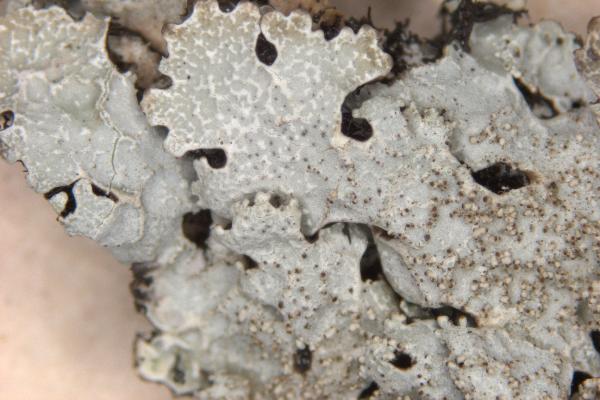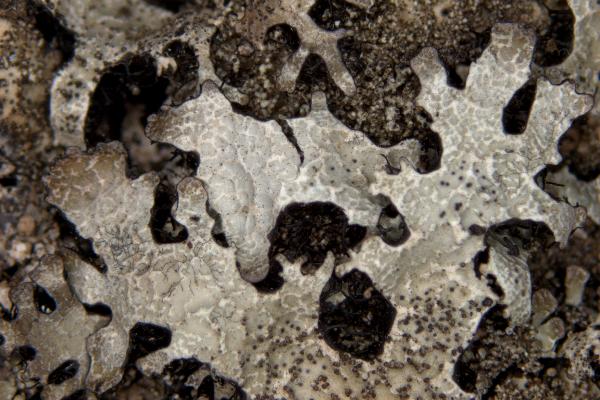Parmelia neosaxatilis Ossowska, Kosecka & Kukwa
in Dong & al., Fungal Diversity: 80, september 2025.
Synonyms:
Distribution: C - Sar (Dong & al. 2025).
Description: Thallus foliose, isidiate, forming up to 6 cm wide patches, the lobes sublinear, to 3 mm wide, nor overlapping, with truncate ends. Upper surface grey to grey brown, often brown at lobe-tips, with laminal and marginal lobules, epruinose and shiny to strongly pruinose, with abundant, marginal and laminal, linear to irregular pseudocyphellae which are connected with each other forming a reticulate, white network at least on young lobes, where they are often elevated, giving the thallus a shallowly scrobiculate appearance. Isidia numerous, mainly laminal and concentrated in central part of thallus, sparse at lobe tips, mostly arranged in lines along the pseudocyphellae, globose to cylindrical, simple to sparingly branched, darkening at apex (sometimes almost black), up to 0.5 mm thick, often spathulate and sometimes forming secondary lobules. Lower surface black in central parts, brown at margins, with laminal and marginal, black, simple to furcate rhizines. Apothecia very rare, lecanorine, never found in the mature state. Pycnidia black, laminal, immersed. Conidia 5-7 x c. 1 μm. Photobiont chlorococcoid. Spot tests: upper cortex K+ yellow (but often slowly turning orange-red due to medullary substances), C-, KC-, P- or P+ faintly yellow; medulla K+ yellow turning orange-red, C-, KC-, P+ orange-red, UV-. Chemistry: upper cortex with atranorin and chloroatranorin; medulla with salazinic acid and related substances; fatty acids absent.Note: a recently-described saxicolous species, hitherto known only from Sardinia and perhaps endemic to the Island, which differs from other isidiate Parmelia-species in molecular characters, in the reticulate pseudocyphellae and in other minor morphological characters. For further details and a discussion of the differences towards similar isidiate species see Ossowska & al. in Dong & al. (2025).
Growth form: Foliose
Substrata: rocks
Photobiont: green algae other than Trentepohlia
Reproductive strategy: mainly asexual, by isidia, or isidia-like structures (e.g. schizidia)
Commonnes-rarity: (info)
Alpine belt: absent
Subalpine belt: absent
Oromediterranean belt: absent
Montane belt: absent
Submediterranean belt: very rare
Padanian area: absent
Humid submediterranean belt: very rare
Humid mediterranean belt: very rare
Dry mediterranean belt: absent

Predictive model
Growth form: Foliose
Substrata: rocks
Photobiont: green algae other than Trentepohlia
Reproductive strategy: mainly asexual, by isidia, or isidia-like structures (e.g. schizidia)
Commonnes-rarity: (info)
Alpine belt: absent
Subalpine belt: absent
Oromediterranean belt: absent
Montane belt: absent
Submediterranean belt: very rare
Padanian area: absent
Humid submediterranean belt: very rare
Humid mediterranean belt: very rare
Dry mediterranean belt: absent

Predictive model



